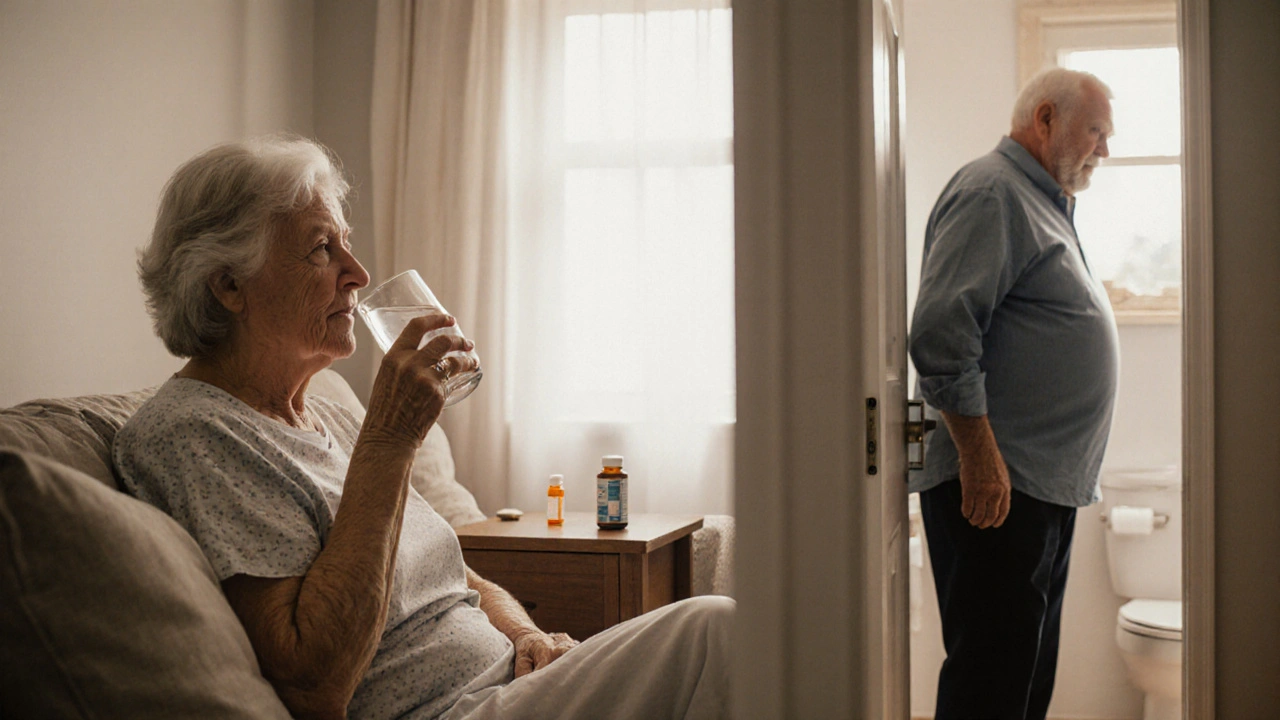When dealing with an overactive bladder, the first medication many doctors prescribe is Ditropan, also known as Oxybutynin. It is an anticholinergic pill that relaxes bladder muscles to reduce urgency and frequency. While effective for many, it isn’t a perfect fit for everyone-some patients experience dry mouth, constipation, or blurry vision that outweigh the benefits.
Why a Comparison Matters
Choosing the right bladder drug isn’t just about grabbing the first prescription. Age, other health conditions, and personal tolerance to side effects all play a role. Comparing Ditropan to its peers helps you pinpoint a medication that balances symptom control with a manageable side effect profile.
Key Players in the Overactive Bladder Market
- Oxybutynin (brand: Ditropan) - Anticholinergic
- Tolterodine (Detrol) - Anticholinergic
- Solifenacin (Vesicare) - Anticholinergic
- Darifenacin (Enablex) - Anticholinergic
- Trospium (Sanctura) - Anticholinergic
- Fesoterodine (Toviaz) - Anticholinergic
- Mirabegron (Myrbetriq) - β‑3 adrenergic agonist
Quick Takeaways
- Ditropan works well for mild‑to‑moderate symptoms but often causes anticholinergic side effects.
- Newer anticholinergics (e.g., Solifenacin, Fesoterodine) tend to have smoother dosing schedules and fewer cognitive complaints.
- Mirabegron offers a non‑anticholinergic option, ideal for older adults or those with glaucoma.
- Cost varies: generic Oxybutynin is cheapest; branded drugs can be 2‑4× more expensive.
- Always discuss kidney function and other meds with your doctor before switching.
Side‑Effect Profiles in Plain Language
Side effects drive many switches. Here’s what patients most often report:
- Dry mouth - common with all anticholinergics; most severe with Oxybutynin.
- Constipation - reported by 20‑30% of users on high‑dose Oxybutynin.
- Blurred vision - usually temporary, more frequent with older anticholinergics.
- Hallucinations or confusion - a concern for seniors on Oxybutynin; newer agents show lower rates.
- Increased blood pressure - specific to Mirabegron; monitor if you have hypertension.
Head‑to‑Head Comparison Table
| Drug (Brand) | Class | Typical Dose | Onset (hrs) | Common Side Effects | Pros | Cons |
|---|---|---|---|---|---|---|
| Ditropan (Oxybutynin) | Anticholinergic | 5‑10 mg PO q8‑12h | 1‑2 | Dry mouth, constipation, blurred vision | Low cost, long‑track record | Higher cognitive side effects, frequent dosing |
| Detrol (Tolterodine) | Anticholinergic | 2‑4 mg PO q24h | 2‑3 | Dry mouth (moderate), mild constipation | Once‑daily dosing, fewer cognitive effects | More expensive than generic Oxybutynin |
| Vesicare (Solifenacin) | Anticholinergic | 5‑10 mg PO q24h | 2‑4 | Dry mouth, constipation, rarely blurred vision | Very low incidence of dizziness, good for older adults | Higher price, may need dose titration |
| Enablex (Darifenacin) | Anticholinergic | 7.5‑15 mg PO q24h | 3‑5 | Dry mouth (mild), constipation | Selective M3 receptor - less heart rate impact | Costly, limited generic availability |
| Sanctura (Trospium) | Anticholinergic (quaternary) | 20‑60 mg PO q8‑12h | 2‑4 | Dry mouth (moderate), urinary retention (rare) | Doesn’t cross blood‑brain barrier - lower cognitive risk | Multiple daily doses, GI upset |
| Toviaz (Fesoterodine) | Anticholinergic | 4‑8 mg PO q24h | 2‑4 | Dry mouth, constipation, possible hypertension | Dose flexibility, good symptom control | Price higher than generics |
| Myrbetriq (Mirabegron) | β‑3 Adrenergic Agonist | 25‑50 mg PO q24h | 4‑6 | Increased BP, nasopharyngitis, headache | Non‑anticholinergic - safe for dementia patients | More expensive, may raise blood pressure |
How to Pick the Right Option for You
- Assess symptom severity. Mild cases often respond to low‑dose Oxybutynin; moderate‑to‑severe cases may need newer agents.
- Review existing health conditions. If you have glaucoma, constipation issues, or are over 65, steer toward drugs with low central nervous system penetration (Trospium, Mirabegron).
- Consider cost and insurance coverage. Generic Oxybutynin is the most budget‑friendly, while Mirabegron may need prior authorization.
- Trial period. Most doctors start with a low dose for 2‑4 weeks, then adjust based on efficacy and side‑effects.
- Monitor labs. Kidney function affects dosing for many anticholinergics; Mirabegron requires periodic blood pressure checks.
Real‑World Stories (Anonymous)
Emily, 58, tried Ditropan after a sudden urge to run to the bathroom every hour. Within a week, she loved the speed of relief, but the dry mouth made her avoid coffee. Her urologist switched her to Solifenacin, which cut the dry mouth in half while keeping urgency under control.
James, 73, has mild dementia. His doctor avoided Oxybutynin because of cognitive risk and started Mirabegron. After six weeks, James reported a 60% drop in nighttime trips with no confusion episodes.

Potential Pitfalls and How to Avoid Them
- Mixing anticholinergics with other dry‑mouth causing meds (e.g., antihistamines) can amplify discomfort. Ask your pharmacist for a review.
- Skipping doses because of side effects can cause rebound urgency. If side effects dominate, discuss dose reduction before stopping.
- Assuming “generic equals weak”. Generic Oxybutynin has the same active ingredient; efficacy differences usually stem from patient tolerance.
- Ignoring drug interactions. Anticholinergics can magnify effects of other anticholinergic meds like tricyclic antidepressants.
Bottom Line
If you prioritize low cost and need fast relief, Ditropan remains a solid first‑line choice. If you’re older, have chronic constipation, or are on multiple anticholinergic drugs, newer agents or Mirabegron may offer a smoother experience. Always have a frank conversation with your prescriber-tailoring the right drug saves you trips to the bathroom and trips to the pharmacy.
Frequently Asked Questions
Can I take Oxybutynin and Mirabegron together?
Usually no. Combining an anticholinergic with a β‑3 agonist doesn’t give extra benefit and may increase side‑effects. Doctors sometimes use both for refractory cases, but it requires close monitoring.
Is there a non‑prescription alternative to Ditropan?
Lifestyle changes-bladder training, reduced caffeine, pelvic floor exercises-help many mild cases. Some over‑the‑counter supplements claim benefit, but scientific support is limited compared to prescription meds.
Why do older adults often avoid Oxybutynin?
Age‑related changes in the brain make anticholinergic side effects-confusion, memory lapses-more likely. Safer options like Trospium or Mirabegron have lower central nervous system penetration.
How long does it take for Oxybutynin to start working?
Most patients feel reduced urgency within 1‑2hours of the first dose. Full steady‑state effect usually appears after 3‑5days of consistent dosing.
Can I switch from Oxybutynin to another drug without a wash‑out period?
Typically you can transition directly; the new medication’s dosing starts the day after the last Oxybutynin dose. However, discuss timing with your doctor to monitor for overlapping side effects.





Soumen Bhowmic
October 10, 2025 AT 01:27When I first got prescribed Ditropan I was skeptical because I had read about the dry‑mouth nightmare that often tags anticholinergics.
After a week of 5 mg three times daily I noticed a real drop in nighttime trips, which was a blessing for my restless sleepers.
The first side‑effect showed up as a cotton‑mouth feeling that made water bottles my new best friends.
I tried chewing sugar‑free gum, and that helped a bit, but the sensation lingered for most of the day.
Constipation crept in around day three, so I added a high‑fiber diet and a probiotic supplement to keep things moving.
Meanwhile, the urgency was tamed enough that I could finish a coffee without sprinting to the bathroom.
My doctor suggested a lower dose after two weeks, and the side‑effects softened while the bladder control remained solid.
What surprised me was the speed of onset; within two hours I felt the urge recede, which is faster than many newer agents I’ve tried.
Cost was another major win – the generic pill was a fraction of the price of the brand‑name solifenacin my neighbor was on.
On the downside, the cognitive fog that shows up in older patients was mild for me, but I still felt a little less sharp when the dose peaked.
Balancing the pros and cons, I kept Ditropan as my go‑to for mild to moderate symptoms, only switching if the dry mouth became unbearable.
It’s also worth noting that mixing it with antihistamines amplified the dryness, so I asked my pharmacist to review my meds.
Kidney function tests were normal, which allowed the standard dosing without adjustments.
Overall, the medication gave me a usable quality‑of‑life boost without breaking the bank.
If you’re on a tight budget and can tolerate a bit of mouth dryness, Ditropan remains a solid first‑line option.
Jenna Michel
October 10, 2025 AT 16:27The pharmacodynamic profile of oxybutynin demonstrates rapid muscarinic receptor antagonism, leading to prompt detrusor stabilization-ideal for patients craving immediate symptom abatement! However, clinicians must vigilantly monitor anticholinergic burden, especially when polypharmacy introduces additive xerostomia, constipation, and blurred visual acuity; these adverse events can precipitate non‑adherence. In real‑world settings, the bioavailability variance between immediate‑release and extended‑release formulations can skew therapeutic windows, demanding dose titration algorithms that incorporate renal clearance metrics. For geriatric cohorts, the central nervous system penetration of low‑lipophilicity agents escalates the risk of cognitive impairment, a parameter often under‑reported in clinical trials. Comparative effectiveness research underscores that solifenacin and fesoterodine exhibit lower incidence of cognitive side effects due to their selective M3 antagonism, albeit at a higher cost tier. Cost‑utility analyses reveal that generic oxybutynin maintains a favorable incremental cost‑effectiveness ratio (ICER) when quality‑adjusted life‑years (QALYs) are derived primarily from urgency reduction. Bottom line: tailor the anticholinergic regimen to the patient’s comorbidity spectrum, side‑effect tolerance, and pharmacoeconomic constraints.
Abby Richards
October 11, 2025 AT 07:27Ditropan works fast but the dry mouth can be brutal 😖.
Rajesh Kumar Batham
October 11, 2025 AT 22:27👍 Totally agree with your timeline – the first 48 hours are key, and a simple gum or sip of water can really soften that cotton‑mouth feeling.
Bill Gallagher
October 12, 2025 AT 13:27When evaluating the therapeutic hierarchy of anticholinergic agents for overactive bladder, it is essential to consider not only the pharmacokinetic parameters-absorption rate, bioavailability, half‑life-but also the nuanced patient‑reported outcomes that encompass quality of life indices, adherence rates, and the socioeconomic variables that influence medication accessibility; consequently, one must adopt a multidimensional analytical framework that integrates clinical efficacy data from double‑blind randomized controlled trials with real‑world evidence derived from registry databases and pharmacovigilance reports. The comparative efficacy of oxybutynin versus newer agents such as solifenacin, darifenacin, and fesoterodine has been addressed in numerous meta‑analyses, which consistently demonstrate that while the newer agents may offer marginally improved side‑effect profiles-particularly concerning cognitive impairment-the absolute difference in urgency reduction is often statistically insignificant; therefore, cost‑effectiveness becomes a pivotal determinant in decision‑making, especially for patients without comprehensive insurance coverage. Moreover, the pharmacodynamic distinction between competitive muscarinic blockade and selective M3 antagonism underscores the importance of receptor affinity and tissue selectivity, which can translate into varying degrees of systemic anticholinergic load; this is particularly relevant for polypharmacy scenarios in elderly populations where additive serotonergic and anticholinergic burden may precipitate delirium or exacerbate existing neurocognitive deficits. In practice, initiating therapy with a low‑dose immediate‑release formulation of oxybutynin and titrating upward based on symptom control and tolerability can mitigate adverse events, while also providing an opportunity to assess patient preference regarding dosing frequency-once‑daily versus multiple daily administrations-and thereby enhance adherence. Finally, clinicians should remain cognizant of the emerging data on β‑3 adrenergic agonists such as mirabegron, which, despite a higher acquisition cost, offer a non‑anticholinergic mechanism of action that may be preferable for patients with contraindications to anticholinergics or those who have experienced intolerable side‑effects with traditional agents; however, one must also monitor for potential elevations in blood pressure, a known class effect of mirabegron, necessitating periodic cardiovascular assessment.
Rajashree Varma
October 13, 2025 AT 04:27Great points-especially about cost; many patients overlook insurance nuances.
Anshuman Pandey
October 13, 2025 AT 19:27In the grand tapestry of bodily signals the bladder whispers a truth about balance-when medicine silences that whisper with force we must ask what harmony we have disturbed the ancient rhythm of elimination invites contemplation on the mind‑body interface and reminds us that each dose is a dialogue not a decree the quest for relief should be guided by wisdom as much as by chemistry
Thomas Malloy
October 14, 2025 AT 10:27Sounds like a thoughtful take.
Sushma Gowda
October 15, 2025 AT 01:27I totally get the frustration of juggling side effects and symptom control-finding the sweet spot between efficacy and tolerability feels like a marathon, not a sprint. If you’re dealing with relentless dry mouth, try sipping water throughout the day, using sugar‑free lozenges, or even a humidifier at night; small tweaks can make a big difference. And remember, many pharmacies offer medication therapy management services where a pharmacist can review all your meds for hidden anticholinergic interactions. Keep a simple journal of your bladder episodes and any side effects; patterns often emerge that guide the next dosing adjustment. You’re not alone in this, and with a bit of trial and error you’ll land on the regimen that lets you live life without the constant bathroom alarms.
Angie Wallace
October 15, 2025 AT 16:27Thanks for the practical tips-I'll start a log tonight 🙂.
Doris Montgomery
October 16, 2025 AT 07:27Looks like a thorough rundown, though the table could use more color.
Nick Gulliver
October 16, 2025 AT 22:27Honestly this whole over‑the‑counter hype is just a distraction from real American innovation in urology-our own research labs produce the best bladder meds.
Sadie Viner
October 17, 2025 AT 13:27Allow me to elucidate the gravitas of this discourse: the juxtaposition of antiquated anticholinergics against avant‑garde β‑3 agonists epitomizes a battle between tradition and progress, wherein each therapeutic armament bears its own heraldic crest of benefits and perils. The venerable oxybutynin, with its storied legacy, wields a double‑edged sword of swift efficacy and palpable xerostomia, whilst mirabegron, the youthful virtuoso, serenades the detrusor muscle through adrenergic pathways, sparing the patient the dreaded cognitive fog yet exacting a fiscal toll. In the theater of clinical decision‑making, one must don the mantle of a sagacious adjudicator, weighing the ledger of patient‑centred outcomes against the inexorable tide of pharmacoeconomic constraints. Thus, the ultimate prescription shall emerge not from blind allegiance to either faction, but from a harmonious synthesis calibrated to the individual's physiological tableau and socioeconomic backdrop.
Kristen Moss
October 18, 2025 AT 04:27Totally feel you-sometimes you just gotta pick the cheaper one and deal with the side effects.
Rachael Tanner
October 18, 2025 AT 19:27The pharmaco‑graphic landscape of overactive bladder reads like a kaleidoscope of molecular artistry, each agent brandishing its own chromatic palette of efficacy, tolerability, and fiscal hue; navigating this vivid tableau demands both a discerning eye and a steadfast compass.
Debra Laurence-Perras
October 19, 2025 AT 10:27It's wonderful to see such diverse perspectives shared; understanding cultural nuances in how patients perceive side effects can truly enhance shared decision‑making and promote inclusive care.
dAISY foto
October 20, 2025 AT 01:27omg i totally get why u r scared of dry mouth it rly sucks but try a sugar free gum or a lil water bottle on the go OMG it can make a differece!!
Ian Howard
October 20, 2025 AT 16:27Picture this: you’re standing at the crossroads of cost and comfort, a generic pill in one hand and a brand‑name marvel in the other, each whispering promises of relief. The choice isn’t merely financial-it’s an ode to your daily rhythm, a dance between freedom from nocturnal trips and the serenity of a manageable side‑effect profile. Embrace the path that aligns with your life’s tempo, and let the bladder’s chorus fade into a gentle hum.
Chelsea Wilmer
October 21, 2025 AT 07:27When one delves into the labyrinthine corridors of overactive bladder therapeutics, it becomes evident that the superficial dichotomy of “old versus new” belies a much more intricate tapestry of pharmacologic subtleties, patient-specific variables, and health‑economic considerations that together shape the clinician’s ultimate prescribing decision. The venerable anticholinergic, oxybutynin, has withstood decades of scrutiny, its efficacy well‑documented, yet its proclivity for xerostomia, constipation, and, in the geriatric cohort, cognitive slowing has prompted a migration toward agents with purportedly superior tolerability profiles such as solifenacin and fesoterodine, whose selective receptor affinities and longer half‑lives confer smoother dosing regimens and a mitigated anticholinergic burden. Simultaneously, the emergence of mirabegron, a β‑3 adrenergic agonist, has introduced a non‑anticholinergic paradigm shift, offering an alternative pathway to detrusor relaxation while sidestepping the classic cholinergic side‑effects that have historically hampered adherence. However, this pharmacological innovation is not without its own caveats: the propensity for modest elevations in systemic blood pressure necessitates vigilant monitoring, particularly in patients with pre‑existing hypertension, and the cost differential often places mirabegron beyond the reach of under‑insured populations, thereby re‑enforcing the relevance of cost‑effective generics in many therapeutic algorithms. Moreover, the real‑world application of these agents is further complicated by polypharmacy, renal function considerations, and the heterogeneity of patient‑reported outcomes, which collectively demand a personalized, evidence‑based approach that transcends a simplistic “one‑size‑fits‑all” mentality. In essence, the optimal management of overactive bladder resides at the intersection of clinical evidence, patient preference, and pragmatic health‑system constraints, urging clinicians to wield a nuanced, patient‑centric lens when navigating this ever‑evolving therapeutic landscape.
David Stout
October 21, 2025 AT 22:27Hey folks, just a reminder: whichever route you take, involve your urologist early, keep an open dialogue about side effects, and remember that many patients find success by combining lifestyle tweaks with medication-teamwork makes the dream work.